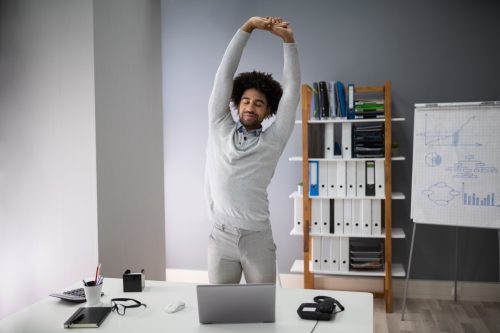10 Easy Ways to Improve Your Posture No Matter Your Age

Bad posture can really take a toll on you. Besides affecting your appearance, it can also have notable health impacts. Back pain, headaches, and joint damage are just a few of the potential consequences of poor posture. Thankfully, it’s never too late to correct how you sit or stand. Ready to put your posture problems behind you? Read on for 10 expert-backed tips on how to improve your posture, no matter your age.
RELATED: 6 Things Your Lower Back Wishes You’d Stop Doing, According to Doctors.
1
Upgrade your office equipment.

Given that the average American worker spends eight-and-a-half hours per day at their jobs, your office equipment can have a tremendous impact on your posture and pain levels. That’s why Kevin Lees, DC, chiropractor and the director of chiropractic operations for The Joint Corp, recommends getting a standing desk and ergonomic chair.
“It may seem like the latest craze, but a standing desk allows you to keep that good posture throughout the day and improves your circulation,” Lees tells Best Life. “It also helps keep postural muscles active.”
Ergonomic office chairs are also “made to support your spine, so when relaxed, the natural curves are maintained,” he points out.
“Unsupportive chairs that don’t fit well can leave a person uncomfortable, developing pain after a short period of sitting, causing the person to shift in their seat and slump,” Lees explains. “Using the built-in support in a chair allows the muscles to relax without developing poor posture.”
Todd Goldman, DC, chiropractor with Total Chiropractic Care & Wellness, adds that pillows and lumbar support cushions can help improve your posture while sitting as well.
2
Keep technology at eye level.

The use of technology often contorts our bodies into unusual positions, which can train us to use poor posture throughout the day. One of the most common complaints is “text neck,” or neck pain resulting from looking downward to text. Similarly, “Mac back” refers to the spinal pain people often feel after sitting in front of a computer for too long.
Lees suggests keeping your phone or computer at eye level when texting and browsing, to retrain your body into a more comfortable posture. Using technology less frequently overall can also improve your body stance.
3
Take regular breaks.

No matter what you’re doing, you shouldn’t be staying in the same position for an extended amount of time. “Sitting for long periods, especially with bad posture, can be fatal,” cautions Calum Fraser, Australian physiotherapist and owner of Advantage Physiotherapy.
Instead, Fraser recommends taking regular breaks every 30 minutes to stand up, stretch, and move around.
“This assists in resetting your positions and preventing muscle rigidification,” he explains.
RELATED: 6 Ways to Reduce the Health Risks of Sitting All Day, According to Experts.
4
Practice good sleeping habits.

The hours when you’re not awake and working are also important.
“How you sleep can affect your posture,” Fraser confirms.
If possible, the physiotherapist advises against sleeping face down at all, as “this can result in neck strain and misalignment.” But you may still need to make certain changes in other sleeping positions as well.
“When sleeping on your back, place a pillow under your knees to maintain the normal curve of the spine,” he suggests. “If you rest on one side, it is advisable to put a cushion between the knees so that it keeps the spine in line with it.”
5
Try lifting weights.

Weight-lifting exercises that specifically target the muscles of the upper back and scapula can also dramatically improve your posture, according to Josh Weight, fitness expert and the director of Gravity Physio. In particular, he recommends trying rows, face pulls, and YTW exercises, which are named after the shapes your arms form while doing them.
“Strengthening these muscles helps retract and stabilize the shoulders, creating a solid foundation for improved posture. A stronger upper back not only promotes better alignment but also reduces the strain placed on the neck and lower back muscles,” Weight says. “By cultivating balanced strength in these areas, you encourage a more upright and aligned posture naturally.”
6
Do yoga or pilates.

Getting regular exercise—ideally at least 150 minutes per week, according to the Centers for Disease Control and Prevention (CDC)—can also improve your posture at any age. For optimal results, doctors recommend yoga or pilates, which can simultaneously build core strength, stretch your muscles, and improve your posture through better body awareness.
“Moving and stretching often will keep your muscles stimulated and your posture long,” Lees shares. “Exercises that are designed to strengthen your core muscles that support your spine result in a straighter carriage.”
Weight agrees that focusing on your core can put better posture within reach.
“Core-strengthening exercises like planks, bridges, and dead bugs target deep abdominal and spinal muscles that support the spine’s natural curves,” he says. “With better core endurance, the body is better equipped to resist the onset of fatigue-induced slouching or poor posture, resulting in an overall more confident and aligned posture.”
RELATED: Chair Yoga Is the New All-Ages Fitness Trend That Can Make You Look and Feel Younger.
7
Retrain your back with a posture brace.

A back brace is never a permanent fix, and some experts warn that using one often can weaken the muscles you need for better posture. However, Weight says that using a brace selectively can offer insights into how your body feels when it’s in proper alignment—and that’s valuable information to have as you practice new postural habits.
“This external cue can be particularly helpful during the initial phases of posture improvement, reinforcing the body’s correct position and assisting you in becoming more attuned to your body’s alignment,” he notes. “Over time, as your muscles and awareness strengthen, you can gradually reduce reliance on the brace, with the goal of maintaining good posture independently.”
8
Stretch your tight hip flexors.

We tend to focus on the back, neck, and shoulders when we think about improving our posture, but Weight says that some postural problems begin lower down in the hip flexors.
“Tight hip flexors can lead to an anterior pelvic tilt, causing the pelvis to tilt forward and the lower back to arch excessively,” he explains. “By incorporating regular hip flexor stretches, you address this common imbalance, allowing the pelvis to return to a more neutral position. This, in turn, aligns the spine properly, relieving strain on the lower back and promoting an elongated and more comfortable posture.”
9
Wear supportive shoes.

Your feet can affect your posture as well—especially if you’re wearing unsupportive shoes, warns Taher Saifullah, MD, spine and pain management doctor and founder of the Spine & Pain Institute in Los Angeles.
“Proper footwear supports your feet, ankles, and spine, helping to maintain good posture. Choose shoes with good arch support and avoid high heels or unsupportive flats,” he recommends.
RELATED: 7 Worst Shoes for Knee Pain, Podiatrists Say.
10
Visit a chiropractor.

Seeing a chiropractor for an evaluation can help give you a better understanding of how your current posture affects your health and what better posture might look like for you. Getting regular adjustments can also provide hands-on relief for back and neck pain.
“Chiropractic adjustments can realign your spine, release tension, and enhance posture,” says Corinne Kennedy, DC, Wisconsin-based chiropractor and the founder of Kennedy Chiropractic Center.
From there, it’s a matter of mindfulness.
“Good posture starts with awareness. Regularly check in with your body alignment, ensuring your ears, shoulders, and hips are in line. This simple practice sets the foundation for better posture,” she adds.